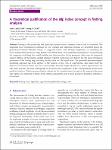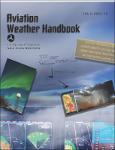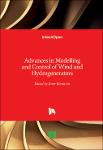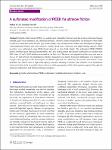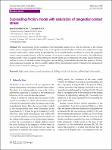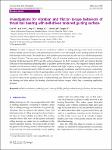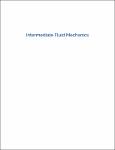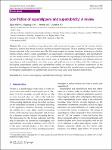Search
Author
- Amir, Ebrahimi (2)
- Aydin, Azizi (2)
- George, Haller (2)
- James, M. Fiore (2)
- next >
Subject
- Engineering (4)
- công nghệ (3)
- kỹ thuật (3)
- Robotics (3)
- next >
Date issued
Search Results
Fretting in the partial-slip and gross-slip regimes under a constant normal load is considered. The tangential force—displacement relations for the forward and backward motions are described based the generalized Cattaneo—Mindlin theory of tangential contact and Masing’s hypothesis on modelling the force—displacement hysteretic loop. Besides the critical force and displacement parameters (characterizing the triggering of sliding), the model includes one dimensionless fitting parameter that tunes the tangential contact stiffness of the friction—contact interface. Explicit expressions are derived for the main tribological parameters of the fretting loop, including the slip index and the signal index. |
This handbook describes the United States (U.S.) aviation weather program, products, and services. It also documents weather theory and its application to aviation. The objective of this handbook is to help the pilot and operator understand the basics of weather, aviation weather hazards, and aviation weather products. The information included is not prescriptive. Furthermore, the guidance and recommendations in this handbook are not legally binding in their own right and will not be relied upon by the FAA as a separate basis for affirmative enforcement action or other administrative penalty. Conformity with the guidance and recommendations is voluntary only and nonconformity will not affect rights and obligations under existing statutes and regulations. |
Triboelectric nanogenerator (TENG) based on triboelectrification has attracted wide attention due to its effective utilization of green energy sources such as marine energy. However, researches about liquid-liquid triboelectrification are still scanty as solid—liquid triboelectrification has been widely studied. Herein, this work focuses on the hydrophobic/slippery substrate—water interfacial triboelectrification based on the solid friction materials of polytetrafluoroethylene (PTFE) nanoparticles. The hydrophobic/slippery substrate—water interfacial triboelectrification are studied by assembling PTFE coated Al sheets and perfluoropolyether (PFPE) infused PTFE coated Al sheets (formed the slippery lubricant-infused surfaces (SLIPSs)) as the friction electrode, and water as liquid fr... |
Rapid deployment of wind and solar energy generation is going to result in a series of new problems with regards to the reliability of our electrical grid in terms of outages, cost, and life-time, forcing us to promptly deal with the challenging restructuring of our energy systems. Increased penetration of fluctuating renewable energy resources is a challenge for the electrical grid. Proposing solutions to deal with this problem also impacts the functionality of large generators. The power electronic generator interactions, multi-domain modelling, and reliable monitoring systems are examples of new challenges in this field. This book presents some new modelling methods and technologies for renewable energy generators including wind, ocean, and hydropower systems. |
Polyether ether ketone (PEEK) is a widely used material for friction pairs due to its excellent mechanical strength, good wear resistance, and chemical inertness. However, some modifications are necessary when PEEK is used as a water-lubricated friction pair. In this study, a novel sulfonation method was developed to design a water-lubricated friction pair with ultralow friction, good wear resistance, and high loading capacity. PEEK powders were sulfonated using ClSO3H and sintered to form bulk plastic. The sulfonated PEEK (SPEEK) plastic exhibited good tribological properties. At a low sliding speed, the friction coefficient was smaller than 0.02 when a 3 wt% NaCl solution was used as the lubricant. The order of magnitude of the wear rate was as low as 10−8 mm3/(N·m). |
The incorporation of the saturation of the tangential contact stress with the increase of the normal contact stress is required for the analysis of the friction phenomenon of solids and structures subjected to a high normal contact stress, which cannot be described by the Coulomb friction condition, in which the tangential contact stress increases linearly with the increase of the normal contact stress. In this article, the subloading-friction model, which is capable of describing the smooth elastic—plastic transition, the static—kinetic transition, and the recovery of the static friction during the cease of sliding, is extended to describe this property. Further, some numerical examples are shown, and the validity of the present model will be verified by the simulation of the test ... |
In order to improve the starved lubrication condition of rolling bearings, three kinds of textures, namely dimple, groove texture, and gradient groove texture, were developed on the guiding surface of thrust ball bearings in this study. The results show that gradient groove texture has the one-way self-driving function of liquid droplets. The root mean square (RMS) value of vibration acceleration of gradient groove textured bearing (GGB) decreased by 49.1% and the kurtosis decreased by 24.6% compared with non-textured bearing (NB) due to the directional spreading effect of gradient groove textures on oil. |
This book is meant to be a second course in fluid mechanics that stresses applications dealing with external potential flows and intermediate viscous flows. Students are expected to have some background in some of the fundamental concepts of the definition of a fluid, hydrostatics, use of control volume conservation principles, initial exposure to the Navier-Stokes equations, and some elements of flow kinematics, such as streamlines and vorticity. It is not meant to be an in-depth study of potential flow or viscous flow, but is meant to expose students to additional analysis techniques for both of these categories of flows. We will see applications to aerodynamics, with analysis methods able to determine forces on arbitrary bodies. We will also examine some of the exact solutions of... |
The overarching aim of this open access book is to present self-contained theory and algorithms for investigation and prediction of electric demand peaks. A cross-section of popular demand forecasting algorithms from statistics, machine learning and mathematics is presented, followed by extreme value theory techniques with examples. In order to achieve carbon targets, good forecasts of peaks are essential. For instance, shifting demand or charging battery depends on correct demand predictions in time. Majority of forecasting algorithms historically were focused on average load prediction. In order to model the peaks, methods from extreme value theory are applied. This allows us to study extremes without making any assumption on the central parts of demand distribution and to predict... |
The issues regarding energy dissipation and component damage caused by the interface friction between a friction pair attract enormous attention to friction reduction. The key-enabling technique to realize friction reduction is the use of lubricants. The lubricants smooth the contact interfaces, achieving an ultralow friction contact, which is called superslippery or superlubricity. At present, superslippery and superlubricity are two isolated research topics. There is a lack of unified definition on superslippery and superlubricity from the viewpoint of tribology. Herein, this review aims at exploring the differences and relations between superslippery and superlubricity from their origin and application scenarios. Meanwhile, the challenges for developing superslippery surface and ... |

